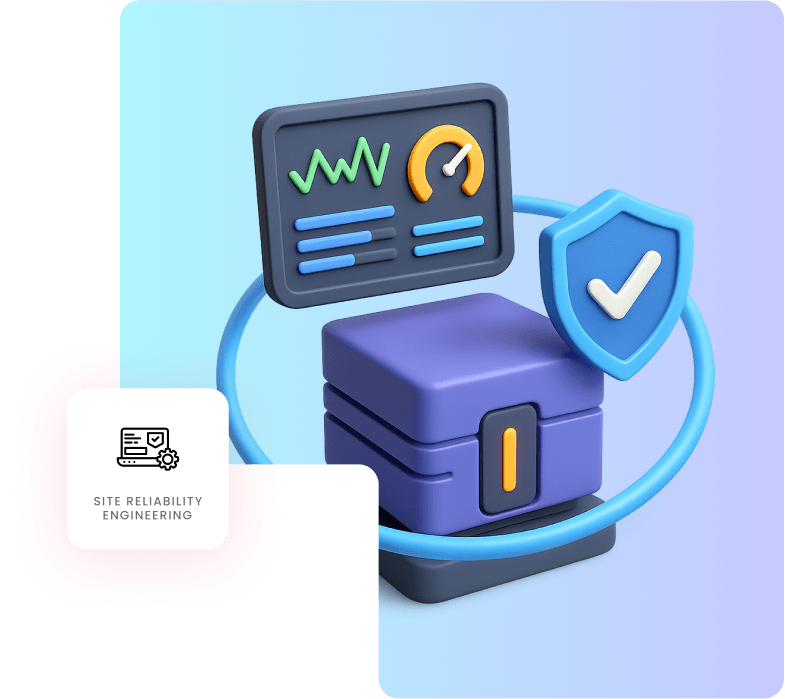Site Reliability Engineering Services to Scale, Secure, and Sustain Your Systems
Power your platforms with Site Reliability Engineering Services that blend automation, observability, and performance resilience. From reducing toil to strengthening SLAs, we engineer reliability into every layer so your systems scale without compromise and sustain without disruption.
Trusted by enterprises running high-traffic, high-scale, and high-availability systems globally

Beyond Ops-as-Usual — SRE That Thinks Forward
niche player in the 2024 Gartner® Magic Quadrant™ for SRE
Modern systems cannot afford unpredictable downtime or reactive firefighting. Our Site Reliability Engineering Services embed reliability, automation, and control into every layer of your tech stack — preventing issues before they escalate.
From infrastructure automation to resilient CI/CD, we build, deploy, and scale SRE capabilities that cut incident volumes, enforce SLAs, and keep systems running predictably.
Key areas we support:
- SRE setup for greenfield & brownfield environments
- SLI/SLO/SLAs calibration and governance
- Kubernetes-native automation & rollback workflows
- Real-time alerting with observability pipelines
- Error budgets, release gating & zero-trust monitoring
Backed by 24/7 global teams, our SRE model ensures faster recovery, risk detection, and continuous performance improvement.
Our Site Reliability Engineering Service Offerings
SRE Consulting & Enablement
Embed SRE principles across teams, workflows, and releases. Align SLIs, SLOs, and error budgets with business goals.
- SRE Maturity Assessment & Roadmap
- SLI/SLO/Error Budget Design & Governance
- Incident Response & Blameless Postmortems
- Org-wide SRE Adoption Playbooks
- Custom SRE Frameworks
Automation-Driven Reliability
Eliminate toil, reduce mean time to repair (MTTR), and build self-healing systems — from CI/CD pipelines to production clusters.
- Runbook Automation & Auto-remediation
- GitOps and Infrastructure-as-Code (IaC)
- Health Checks & Canary Deployments
- Rollback Automation & Safe Deployment Gates
- CI/CD Pipeline Observability
Cloud & Container Reliability
Design fault-tolerant systems across Kubernetes, hybrid, and multi-cloud environments with engineered failover and redundancy.
- Kubernetes Availability Engineering
- Cloud Resource Auto-scaling & Failover
- Cluster Health Monitoring & Alerting
- Multi-region Reliability Engineering
- Chaos Testing & Resilience Validation
Three Pillars of Observability (and the emerging fourth)
Visibility and actionable insights through full-stack pipelines that detect anomalies before users even notice.
- Custom SRE Dashboards (Grafana, Prometheus, Datadog)
- Golden Signal Monitoring & Alert Tuning
- Distributed Tracing (OpenTelemetry, Jaeger)
- Real-time Log Analytics
- Alert Routing & Escalation Policies
SRE Managed Services
End-to-end SRE operations with 24/7 coverage, real-time incident management, and reliability reviews.
- 24x7 SRE Operations Center
- SLA Management & Health SLOs
- Continuous Improvement & Runbook Evolution
- Weekly Ops Reviews with Actionables
- Change Advisory & Reliability Reports
What We Build
Stays Built

Value-Centered Assessment
We assess incidents, gaps, and delivery issues to craft an SRE roadmap that drives measurable reliability improvements.

Modular Engagement
Choose advisory, co-delivery, or managed models — CES scales with your systems, teams, and operational complexity.

Platform-Agnostic Expertise
We deliver stack-agnostic SRE solutions across AWS, Azure, GCP, and OpenShift — aligned to architecture and compliance needs.

Proven Frameworks
Deploy ready-to-use playbooks, alerting templates, and engineering blueprints to speed up incident response and reliability outcomes.
Our End-to-End SRE Solutions Approach
CES provides a comprehensive SRE service lifecycle — from adoption and automation to continuous refinement.
SRE Strategy & Planning
- SRE Governance Models
- Reliability Targets by Application Tier
- SRE-as-a-Service Framework Design
- Failure Simulation & Chaos Testing
- Load & Performance Benchmarking
- Progressive Release Workflows
- Release Engineering Practices
Reliability Architecture
Architect fault-tolerant systems that anticipate failure and minimize blast radius, with high-availability patterns and redundancy.
- Active-Active & Blue-Green Topologies
- Load Balancer Health Routing
- API Gateway Reliability Controls
Incident Lifecycle Engineering
Minimize downtime through structured incident response workflows that enable real-time coordination and faster recovery.
- Incident Lifecycle Automation
- PagerDuty/ServiceNow Integration
- Root Cause Identification (RCI) Tooling
Culture of Resilience
Drive organization-wide SRE mindset through structured enablement, postmortems, and cross-functional rituals.
- Blameless Postmortem Workshops
- Error Budget Enforcement Practices
- Cross-functional Reliability Reviews
Why Site Reliability Engineering Services Matter
- Reduce downtime and operational risk with proactive incident handling
- Scale hybrid and cloud-native systems with engineered confidence
- Gain full-stack observability for faster diagnostics and RCA
- Automate repetitive ops tasks to cut toil and human error
- Improve customer experience and developer velocity in parallel
FAQs
Site Reliability Engineering Services
SRE combines software engineering with IT operations to make systems scalable, stable, and self-healing. It uses automation, observability, and defined service objectives to reduce downtime and operational overhead.
SRE teams automate routine tasks, track reliability metrics (SLIs/SLOs), manage incidents, and run postmortems. They reduce manual work and enforce system health through engineering-led operations.
DevOps promotes collaboration between dev and ops teams. SRE turns that philosophy into practice by setting measurable reliability goals, managing error budgets, and automating responses through code.
SRE services cut downtime, improve incident response, and enable smooth scaling. They help meet SLAs, reduce operational risk, and support faster, safer deployments in modern IT environments.
SLIs (Service Level Indicators) are metrics like latency or uptime. SLOs (Service Level Objectives) are performance targets based on those metrics. Error Budgets define how much unreliability is acceptable. Together, they help SRE teams make data-driven decisions around releases and system health.
Yes. SRE can be gradually applied to legacy and hybrid setups by introducing observability, automation, and incident workflows tailored to the existing environment.
SRE teams commonly use Prometheus, Grafana, Datadog, Splunk, ELK stack, Kubernetes, Terraform, Jenkins, PagerDuty, and ServiceNow. CES tailors your SRE toolchain to your cloud or hybrid infrastructure and compliance needs.
CES offers consulting, co-managed, and fully managed SRE services. We handle setup, automation, monitoring, alert tuning, RCA, and continuous improvement — customized to your ops model.

